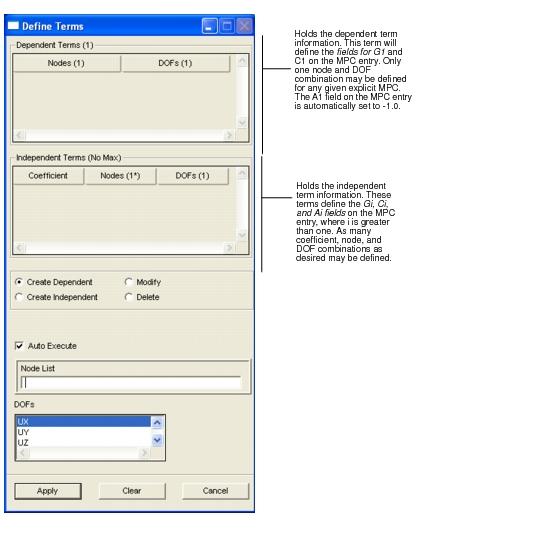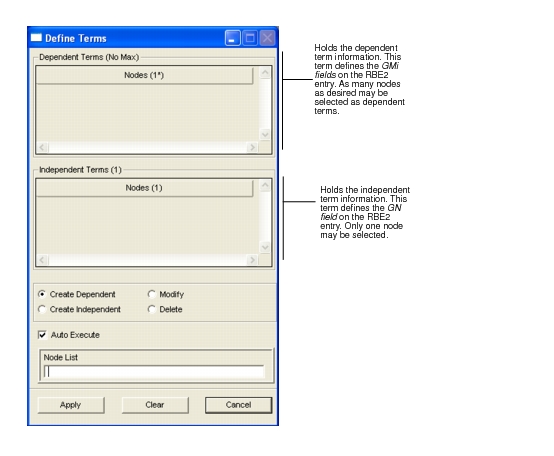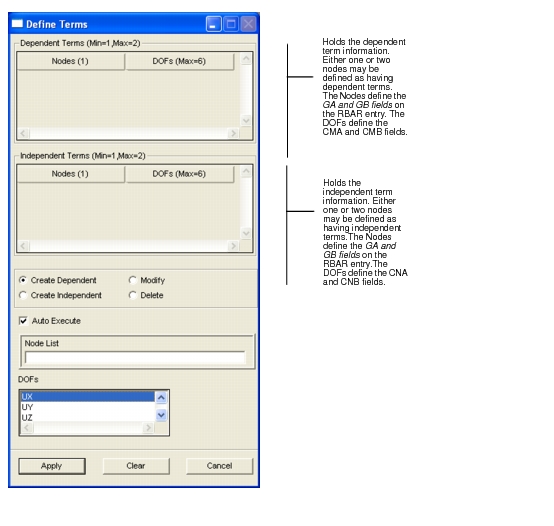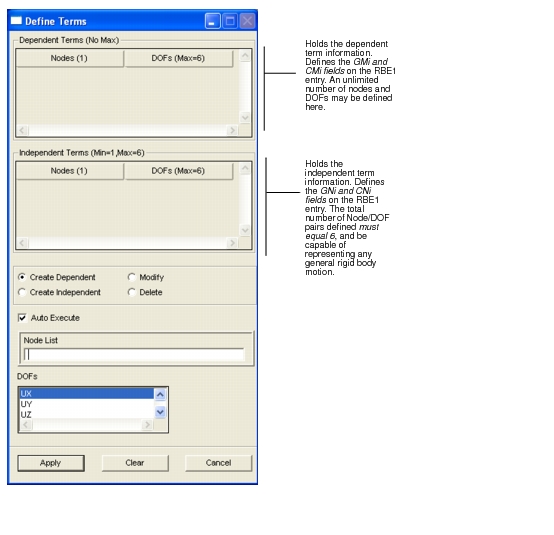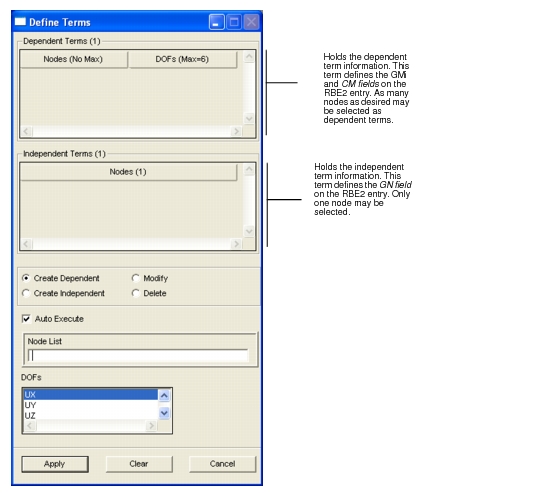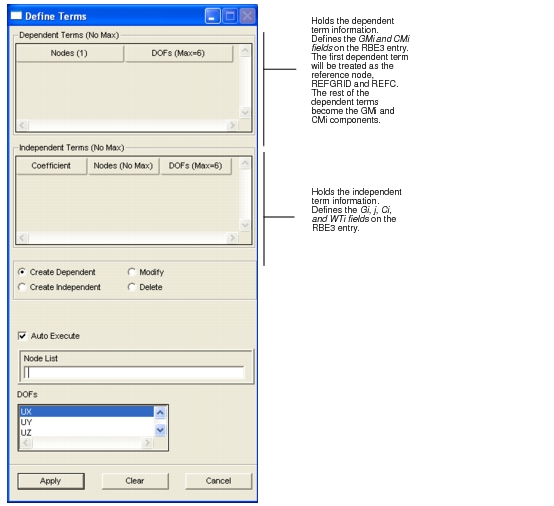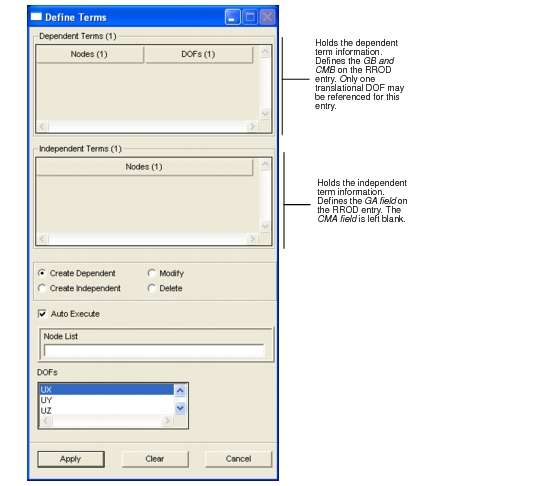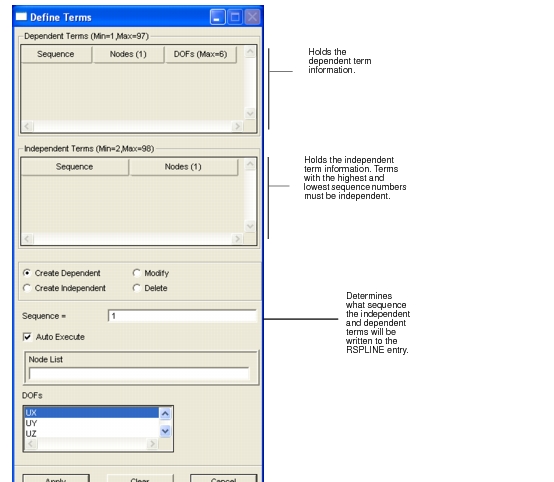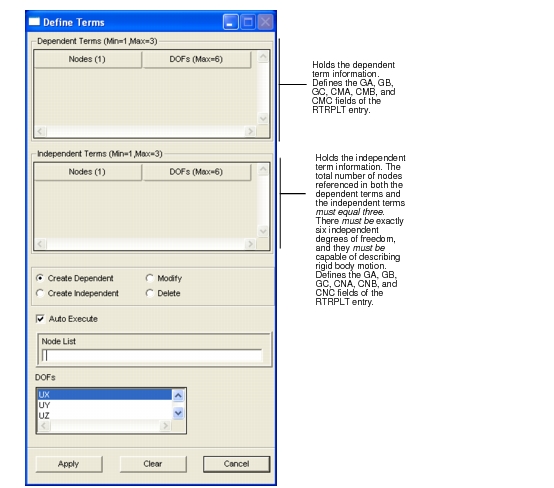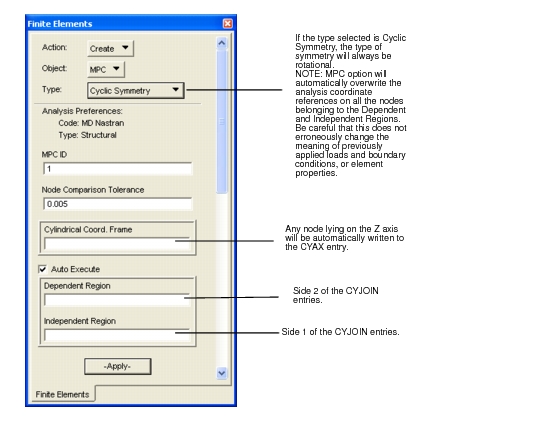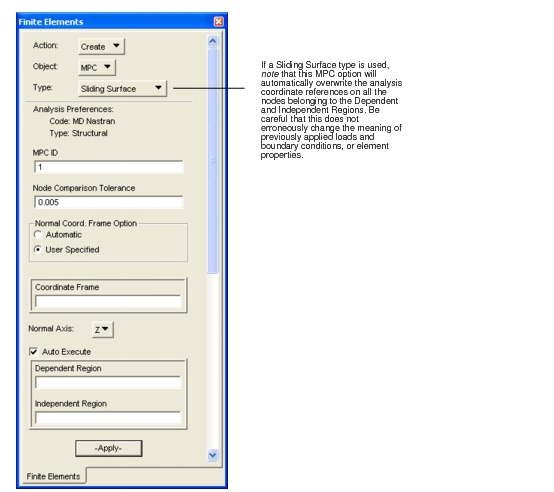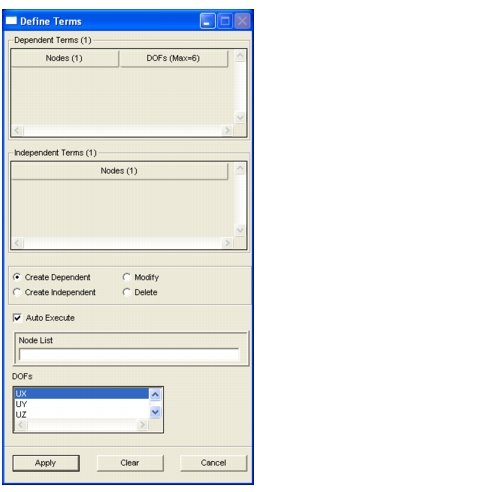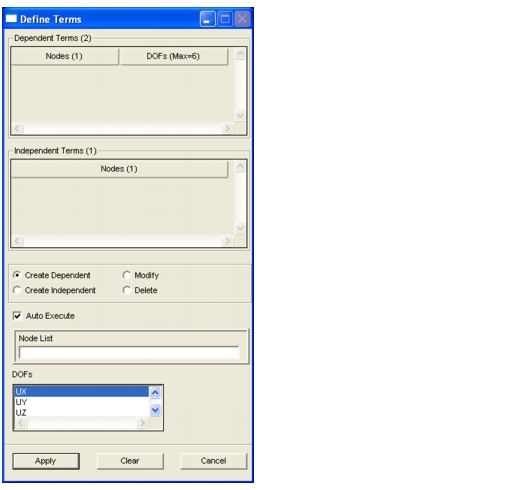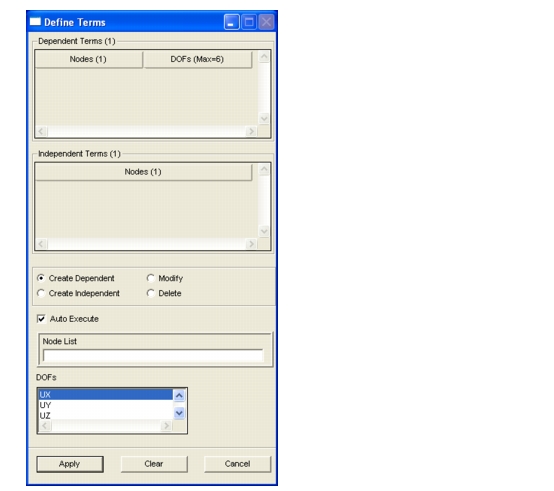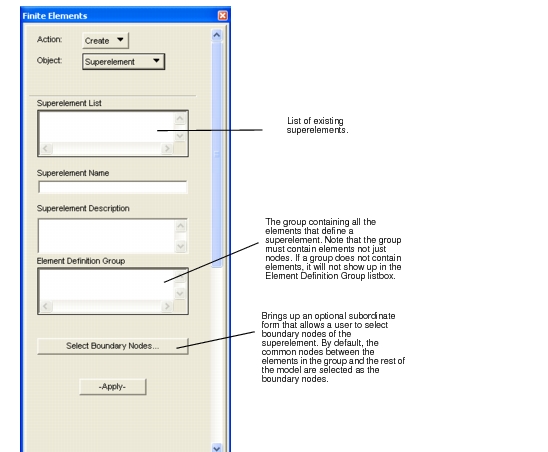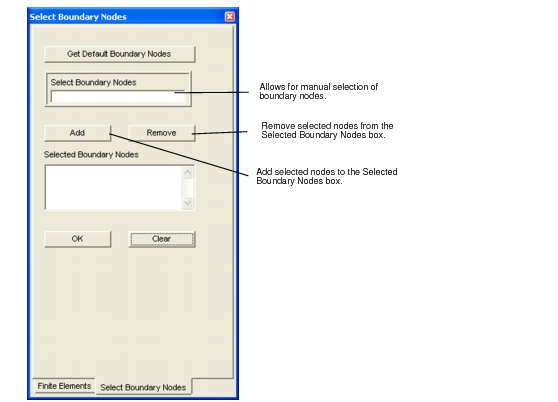

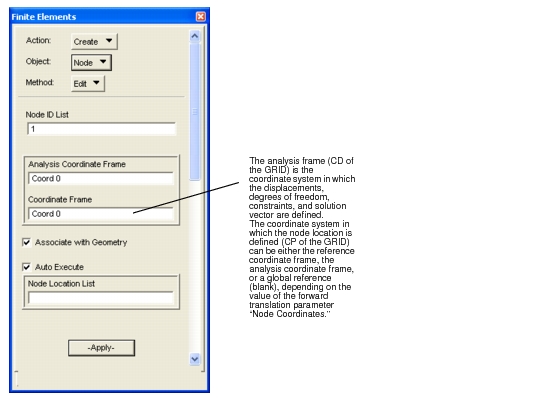
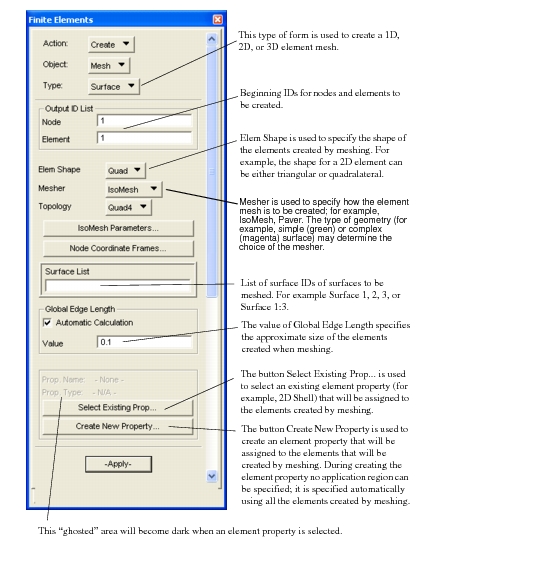
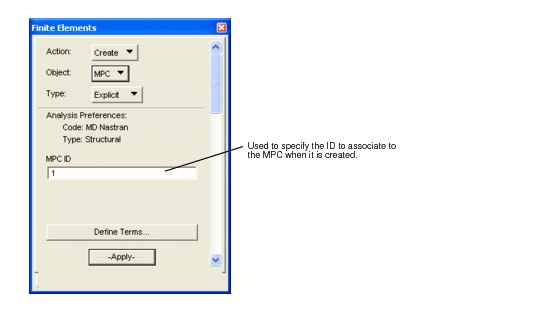
MPC Type | Analysis Type | Description |
Structural | Creates an explicit MPC between a dependent degree of freedom and one or more independent degrees of freedom. The dependent term consists of a node ID and a degree of freedom, while an independent term consists of a coefficient, a node ID, and a degree of freedom. An unlimited number of independent terms can be specified, while only one dependent term can be specified. The constant term is not allowed in MD Nastran. | |
RSSCON Surf-Vol | Structural | Creates an RSSCON type MPC between a dependent node on a linear 2D plate element and two independent nodes on a linear 3D solid element to connect the plate element to the solid element. One dependent and two independent terms can be specified. Each term consists of a single node. |
Structural and Explicit Nonlinear | Creates a rigid MPC between one independent node and one or more dependent nodes in which all six structural degrees of freedom are rigidly attached to each other. An unlimited number of dependent terms can be specified, while only one independent term can be specified. Each term consists of a single node. There is no constant term for this MPC type. | |
RBAR | Structural and Explicit Nonlinear | Creates an RBAR element, which defines a rigid bar between two nodes. Up to two dependent and two independent terms can be specified. Each term consists of a node and a list of degrees of freedom. The nodes specified in the two dependent terms must be the same as the nodes specified in the two independent terms. Any combination of the degrees of freedom of the two nodes can be specified as independent as long as the total number of independent degrees of freedom adds up to six. There is no constant term for this MPC type. |
RBE1 | Structural | Creates an RBE1 element, which defines a rigid body connected to an arbitrary number of nodes. An arbitrary number of dependent terms can be specified. Each term consists of a node and a list of degrees of freedom. Any number of independent terms can be specified as long as the total number of degrees of freedom specified in all of the independent terms adds up to six. Since at least one degree of freedom must be specified for each term there is no way the user can create more that six independent terms. There is no constant term for this MPC type. |
RBE2 | Structuraland Explicit Nonlinear | Creates an RBE2 element, which defines a rigid body between an arbitrary number of nodes. Although the user can only specify one dependent term, an arbitrary number of nodes can be associated to this term. The user is also prompted to associate a list of degrees of freedom to this term. A single independent term can be specified, which consists of a single node. There is no constant term for this MPC type. |
RBE3 | Structuraland Explicit Nonlinear | Creates an RBE3 element, which defines the motion of a reference node as the weighted average of the motions of a set of nodes. An arbitrary number of dependent terms can be specified, each term consisting of a node and a list of degrees of freedom. The first dependent term is used to define the reference node. The other dependent terms define additional node/degrees of freedom, which are added to the m-set. An arbitrary number of independent terms can also be specified. Each independent term consists of a constant coefficient (weighting factor), a node, and a list of degrees of freedom. There is no constant term for this MPC type. |
RROD | Structural | Creates an RROD element, which defines a pinned rod between two nodes that is rigid in extension. One dependent term is specified, which consists of a node and a single translational degree of freedom. One independent term is specified, which consists of a single node. There is no constant term for this MPC type. |
RSPLINE | Structural | Creates an RSPLINE element, which interpolates the displacements of a set of independent nodes to define the displacements at a set of dependent nodes using elastic beam equations. An arbitrary number of dependent terms can be specified. Each dependent term consists of a node, a list of degrees of freedom, and a sequence number. An arbitrary number of independent nodes (minimum of two) can be specified. Each independent term consists of a node and a sequence number. The sequence number is used to order the dependent and independent terms with respect to each other. The only restriction is that the first and the last terms in the sequence must be independent terms. A constant term, called D/L Ratio, must also be specified. |
RTRPLT | Structural | Creates an RTRPLT element, which defines a rigid triangular plate between three nodes. Up to three dependent and three independent terms can be specified. Each term consists of a node and a list of degrees of freedom. The nodes specified in the three dependent terms must be the same as the nodes specified in the three independent terms. Any combination of the degrees of freedom of the three nodes can be specified as independent as long as the total number of independent degrees of freedom adds up to six. There is no constant term for this MPC type. |
Cyclic Symmetry | Structural | Describes cyclic symmetry boundary conditions for a segment of the model. If a cyclic symmetry solution sequence is chosen, such as “SOL 114,” then CYJOIN, CYAX and CYSYM entries are created. If a solution sequence that is not explicitly cyclic symmetric is chosen, such as “SOL 101,” MPC and SPC entries are created. Be careful, for this option automatically alters the analysis coordinate references of the nodes involved. This could erroneously change the meaning of previously applied load and boundary conditions, as well as element properties. |
Structural | Describes the boundary conditions of sliding surfaces, such as pipe sleeves. These boundary conditions are written to the NASTRAN input file as explicit MPCs. Be careful, for this option automatically redefines the analysis coordinate references of all affected nodes. This could erroneously alter the meaning of previously applied load and boundary conditions, as well as element properties. | |
Structural | This is an alternate (simplified) form for RBAR. Creates an RBAR1 element, which defines a rigid bar between two nodes, with six degrees of freedom at each end. Each dependent term consists of a node and a list of degrees of freedom, while the independent term consists only of a node (with all six degrees of freedom implied). The constant term is the thermal expansion coefficient, ALPHA. | |
Structural | Alternative format to define a rigid triangular plate element connecting three grid points. Creates an RTRPLT1 element, which defines a rigid triangular plate between three nodes. Each dependent term consists of a node and a list of degrees of freedom, while the independent term consists only of the node (with all six degrees of freedom implied). The constant term is the thermal expansion coefficient, ALPHA. | |
Structural | Creates an RJOINT element, which defines a rigid joint element connecting two coinciding grid points. Each dependent term consists of a node and a list of degrees of freedom, while the independent term consists only of a node (with all six degrees of freedom implied). There is no constant term for this MPC type. |
Degree of freedom | Analysis Type |
UX | Structural |
UY | Structural |
UZ | Structural |
RX | Structural |
RY | Structural |
RZ | Structural |
Note: | Care must be taken to make sure that a degree of freedom that is selected for an MPC actually exists at the nodes. For example, a node that is attached only to solid structural elements will not have any rotational degrees of freedom. However, Patran will allow you to select rotational degrees of freedom at this node when defining an MPC. |
